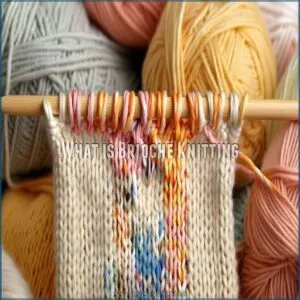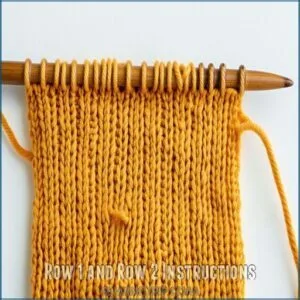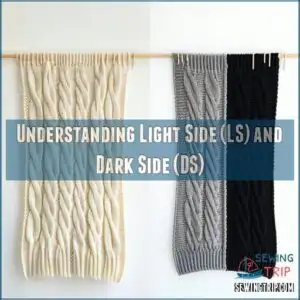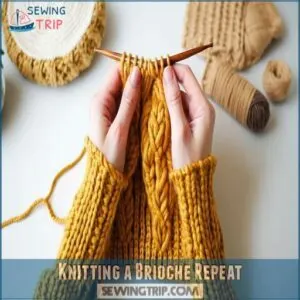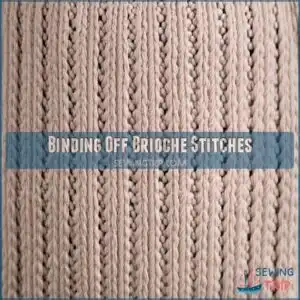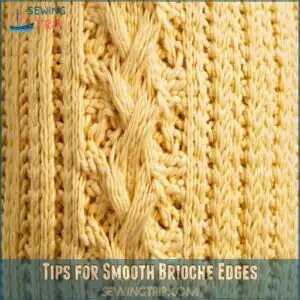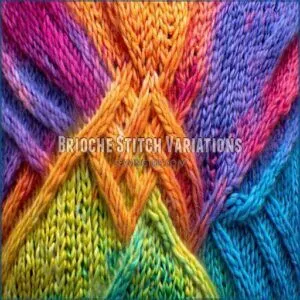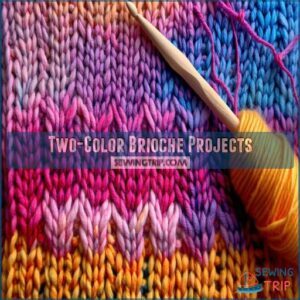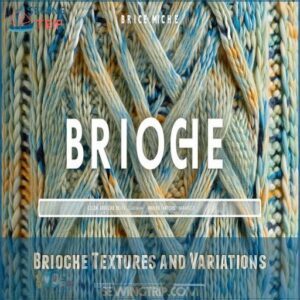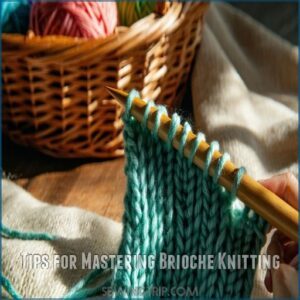This site is supported by our readers. We may earn a commission, at no cost to you, if you purchase through links.
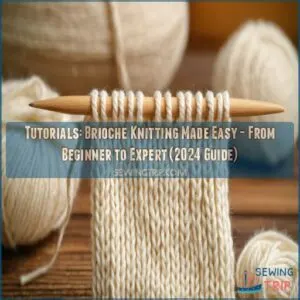
You start by casting on an even number of stitches.
Knit the first stitch, then slip one purlwise with the yarn in front, adding a yarn over.
Keep going until the end.
Here’s where the real magic—row two—begins: Brk (bark) the next stitch, maintaining even tension to avoid droopy edges.
Don’t worry if it feels like coordinating a knitting ballet at first—it soon clicks!
Once you’re familiar with slipping and “barking,” try two-color brioche for a textured masterpiece.
And who knows, maybe you’ll discover your next project inspiration!
Table Of Contents
Key Takeaways
- You’ll create a plush, reversible fabric by mastering brioche knitting’s combination of slipped stitches and yarn overs, allowing for cozy textures perfect for scarves and shawls.
- Start your brioche projects by casting on an even number of stitches, which is essential for building the signature ribbed structure.
- Choose smooth, stretchy yarns like merino wool to enhance stitch definition and avoid using fuzzy yarns that obscure the elegant patterns.
- Practice binding off by treating each brioche stitch and its yarn over as a single unit, ensuring your project’s edges maintain their squishy elasticity.
What is Brioche Knitting
You’ll love brioche knitting, a unique technique that creates wonderfully squishy, reversible fabric using a special combination of slipped stitches and yarn overs.
While it might look fancy enough to serve alongside actual brioche bread (yes, that’s where it gets its name), you’ll find it’s not as tricky as it appears once you understand the basics.
Definition of Brioche Knitting
If you’ve ever wondered what makes brioche knitting special, imagine creating a fabric that’s as soft and squishy as your favorite sweater, but with twice the texture.
Brioche knitting uses a unique combination of slipped stitches and yarn overs to create a deep, reversible ribbed fabric.
It’s like the puffy, tender texture of brioche bread, which inspired its name.
Brioche Knitting History
The rich history of brioche knitting traces back to the mid-18th century Europe, where it gained popularity among aristocrats.
You’ll find its name comes from the French bread’s similar puffy texture.
Early knitters developed the technique to create warm, elastic fabrics for winter garments.
Today’s modern revival has transformed this traditional stitch into a versatile art form embraced by knitters worldwide.
Brioche Knitting Terminology
You’ll encounter some unique terms when diving into brioche knitting, so let’s break down the essential lingo. Here are the key terms you’ll need to know:
- Sl1yo – The foundation of brioche, where you slip a stitch while adding a yarn over
- Light side (LS) – Where your lighter yarn shows prominently
- Dark side (DS) – Where your darker yarn dominates
- Two-color brioche – Creating patterns using contrasting yarns
Brk (Bark) and Brp (Burp) Stitches
Mastering brioche’s essential stitches starts with understanding Brk (bark) and Brp (burp).
Think of Brk as your standard knit stitch, but worked through both loops of a slipped stitch-and-yarn-over combo.
For a more in-depth look at these stitches, check out this detailed brioche stitch tutorial.
Brp is its purled cousin, creating the same effect from the opposite side.
These stitches work together to create that signature squishy, reversible fabric that makes brioche so special.
Sl1yo (Slip 1 Yarn Over)
Through the magic of brioche knitting, sl1yo (slip 1 yarn over) creates that signature squishy texture you’re after.
To achieve this, you need to understand that brioche knitting involves brk and brp stitches, which are created using techniques like knit through both loops.
Simply slip one stitch purlwise while bringing your yarn over the needle – it’ll form a neat X shape. This essential technique lays the foundation for those beautiful brioche ribs.
Think of sl1yo as creating little hugs around your stitches, setting up the fabric’s characteristic loftiness.
How to Start Brioche Knitting
You’ll love starting brioche knitting with its cloud-like texture once you’ve got the basics down – just remember to cast on an even number of stitches to set yourself up for success.
While it might look fancy, you’ll only need to master two simple steps: the setup row with yarn-over slips and the main pattern row that creates those signature squishy ribs.
Casting on Even Number of Stitches
Starting brioche knitting requires an even number of stitches – it’s non-negotiable for creating those signature squishy ribs.
You can find tools and resources specifically designed for long tail brioche at long tail brioche kits.
Cast on using your preferred method, but keep the tension relaxed.
A long-tail cast-on works beautifully here, giving you the perfect foundation for brioche’s rhythmic pattern.
Remember, too tight a cast-on will fight against the natural stretch of brioche fabric.
Row 1 and Row 2 Instructions
Now that you’ve got your stitches cast on, let’s walk through the two foundation rows that’ll set you up for brioche success. Think of these rows as building the framework for your squishy, beautiful fabric.
- Row 1: Keep your yarn in front as you slip the first stitch
- Next, work (k1, sl1yo) across the row
- End with a simple k1 stitch
- Row 2: Begin with another front-facing slip stitch
- Continue with (brk, sl1yo) until the last stitch, then k1
Understanding Light Side (LS) and Dark Side (DS)
In two-color brioche, you’ll notice each side has its own personality.
The light side (LS) shows off your lighter yarn, creating those beautiful V-shaped ribs that pop against the background.
On the flip side, the dark side (DS) lets your darker yarn take center stage.
Think of it like a reversible jacket – both sides look fantastic, just with different color intensities.
Brioche Knitting Basics and Beyond
You’ll master the essential brioche knitting techniques with our step-by-step guide, from creating smooth edges to perfecting those tricky bind-offs.
Brioche patterns that’ll make your friends think you’ve been knitting since birth.
Knitting a Brioche Repeat
Mastering the brioche repeat feels like dancing – once you get into the rhythm, it flows naturally.
Keep track of your rows by counting the V-shaped stitches that form those characteristic brioche columns.
As you work through each row, maintain even tension between your yarn overs and knit stitches.
Think of it as creating a cozy, squishy fabric one stitch at a time.
Binding Off Brioche Stitches
Binding off brioche stitches can seem tricky at first, but it’s actually straightforward.
Using the right tools, such as handy brioche stitch markers, can make all the difference in maintaining your stitch count.
You’ll want to work your final row in pattern before binding off.
Treat each brioche stitch and its paired yarn over as a single stitch, then bind off as normal.
Keep your tension even but not too tight – this helps maintain the fabric’s signature squishiness and prevents any unsightly gaps.
Tips for Smooth Brioche Edges
Achieving smooth edges in brioche knitting doesn’t have to be a headache.
Maintaining consistent tension, much like mastering thread tension for even stitches in hand-sewing projects is key to perfect results, is key to a polished finish.
Start with a loose cast on using needles one size larger than your project calls for.
Keep your tension consistent, especially when working the first and last stitches.
When binding off, work the stitches as they appear – knit the knits and purl the purls – for neat selvedges that’ll make your project look polished.
Brioche Stitch Variations
You’ll discover how brioche knitting transforms from basic stitches into stunning designs using cables, two-color patterns, and creative shaping techniques.
Whether you’re ready to level up your brioche game or just want to add some pizzazz to your knitting, these variations will help you create eye-catching textures that’ll make other knitters ask for your secrets.
Single-Color Brioche Knitting
Single-color brioche creates a luxurious, squishy fabric that’s perfect for cozy winter wear. You’ll get that distinctive honeycomb texture by working with just one yarn, making it an ideal starting point for your brioche journey.
- Start with lighter-colored yarns to better see your stitch definition
- Keep your tension consistent – not too tight, not too loose
- Practice the basic brioche stitch pattern before trying variations
Remember: your first brioche project might look a bit wonky, but that’s perfectly normal. Like riding a bike, once you get the rhythm, you’ll be wondering why it ever seemed tricky.
Two-Color Brioche Knitting
Two-color brioche takes your knitting game to new heights with stunning color combinations that’ll make your projects pop.
You’ll work with two different yarns, alternating rows to create those signature puffy ribs with amazing depth.
Keep your stitch tension even and watch for color pooling – it’s like painting with yarn!
Start with simple patterns before tackling complex charts.
Trust me, the results are worth it.
Brioche Cables and Shaping
Brioche cables add stunning texture to your knitting, creating intricate patterns that’ll make your friends wonder if you’ve got a secret knitting superpower.
You’ll use increases and decreases to shape your fabric, moving stitches left or right to form beautiful twists.
Starting with basic cable patterns, you can work your way up to more complex designs that showcase both texture and color variations.
Two-Color Brioche Projects
Two-color brioche projects let you create eye-catching designs like the Fisherman’s Rib Stitch, while working on fun patterns such as the Isotopy Mitts and Frost Blush Beanie.
You’ll enjoy mastering these vibrant techniques and showing off your new Unified Field Cowl to friends who’ll probably say, "Wait, you made this?
Fisherman’s Rib Stitch
Ready to level up your brioche game? Fisherman’s rib stitch is a close cousin, offering a similar bouncy texture. It’s a fantastic two-color brioche variation!
Here’s what makes it special:
- Simple increases and decreases.
- Creates a beautiful, textured fabric.
- Easy to customize with colors.
- Great for scarves and sweaters.
This stitch is your gateway to more complex brioche projects; it’s surprisingly simple to learn. You’ll be amazed at the results!
Isotopy Mitts and Frost Blush Beanie
Transform your knitting game with Isotopy Mitts and Frost Blush Beanie!
Mixing yarn choices and color combinations, these projects are perfect for mastering brioche knitting techniques.
Even beginners can explore pattern variations and enjoy this brioche knitting tutorial.
Explore brioche knitting patterns to discover creative freedom and craft cozy, vibrant accessories that turn heads and keep those fingers toasty.
Unified Field Cowl
You’ve got your mitts and beanie, so it’s time to switch things up with the Unified Field Cowl. Here’s what you need:
- Yarn Choices: Go bold or subtle—it’s your style.
- Pattern Variations: Add twists for a unique look.
- Construction Tips: Keep it loose for comfort.
- Color Combinations: Let them pop or blend softly in your brioche knitting.
Brioche Textures and Variations
Ready to explore the squishy magic of brioche knitting textures and variations?
You’ll be amazed at how patterns like the Sweet Honey Beret, Marbled Brioche Scarf, and Mason Street Scarf transform simple stitches into wearable art that’ll have you itching to show them off to everyone—even your cat.
Sweet Honey Beret and Marbled Brioche Scarf
Craving more color combinations after two-color brioche? The Sweet Honey Beret and Marbled Brioche Scarf are your ticket to cozy creativity.
| Item | Yarn Choice | Texture Variations | Project Inspiration |
|---|---|---|---|
| Sweet Honey Beret | Soft wool blend | Subtle swirls | Winter accessory staple |
| Marbled Scarf | Merino mix | Bold ribbing | Everyday elegance |
These projects challenge your brioche knitting skills, offering design adventures with yarn.
Bayeux Cowl and Kittredge Wrapper
Explore the world of brioche knitting with the Bayeux Cowl and Kittredge Wrapper!
These patterns offer unique texture and stitch definition, perfect for showing off your yarn choice.
The Bayeux Cowl’s structure and the Kittredge Wrapper’s variations will keep your fingers dancing.
Check out tutorials for project tips, and embrace the rhythmic, meditative flow of brioche knitting.
Caen Cowl and Mason Street Scarf
From the charming Bayeux Cowl to the Caen Cowl and Mason Street Scarf, your brioche journey ascends.
These projects showcase unique pattern variations and color combinations.
As you explore Caen’s construction techniques, remember: the right yarn choice transforms texture.
The Mason Street Scarf blends project tips with brioche basics, offering fresh creativity in every knit and purl.
Tips for Mastering Brioche Knitting
Ready to take your brioche knitting to the next level?
This section offers helpful tips and tricks to avoid common pitfalls and create truly stunning projects—no more accidental yarn overs!
Choosing The Right Yarn and Needles
Exploring brioche textures? Let’s pick your knitting tools like selecting ingredients for a perfect dish!
- Choose a yarn weight that matches your project’s vibe.
- Opt for needle size that comfortably fits your hand.
- Aim for great stitch definition to showcase patterns.
- Make sure yarn drape aligns with your design’s aspirations—achieving that dreamy, squishy fabric!
Counting Visible Stitches for Gauge
Got your yarn and needles? Great! Next, make a gauge swatch to check your stitch count and row count, keeping in mind that working with worsted weight yarn requires understanding yarn gauge and tension.
It’s like testing the waters—see if you’re on track with your pattern repeat and tension control.
Don’t skip this step; it’ll save you from too-tight hats or oversized scarves.
Happy knitting!
Avoiding Common Mistakes in Brioche Knitting
You’ve got your brioche knitting gauge down, but watch out for pesky mistakes like dropping stitches or losing track of yarn overs.
Keep tension controlled to prevent uneven edges.
Remember, the wrong side can trick you, so count rows carefully.
Even seasoned knitters stumble, but with these tips, your brioche knitting tutorials will end up exquisite, not exasperating.
Frequently Asked Questions (FAQs)
How do you knit a brioche stitch edge?
Mastering brioche stitch edges starts by casting on evenly.
Use slip stitches to create neat edges, slipping the first stitch purlwise each row.
It’s like buttering toast, smoothing those border lines for a flawless finish.
What is a brioche stitch?
Brioche knitting creates a squishy, ribbed fabric.
It’s a bit trickier than regular knitting, but the results are totally worth it!
You’ll use slipped stitches and yarn overs to make this super-soft fabric.
How do you bind a brioche?
Think of finishing a knitting marathon: to bind off brioche, slip the first stitch purlwise, knit next as a brioche knit.
Pass the slipped stitch over.
Repeat this across, ensuring tension to maintain elasticity.
How do you knit a brioche repeat?
To knit a brioche repeat, start by casting on an even number of stitches.
Then alternate between brioche knit and slip one yarn over stitches.
Repeating each row until your project reaches the desired length.
Happy knitting!
What is the brioche method of knitting?
Imagine creating fabric as cozy as a daydream!
Brioche knitting is all about crafting a plush, stretchy texture using brioche stitches and slip-yarn-overs.
It’s a bit tricky, but totally worth the amazing reversible patterns you’ll make.
Is brioche knitting difficult?
Brioche knitting isn’t overly difficult.
Once you get the hang of the basic slip yarn overs and brioche knit stitches, you’ll find it’s a rewarding technique.
Brioche knitting creates plush, reversible textures perfect for scarves and shawls.
How many stitches do you cast on for brioche knitting?
You’ll need to cast on an even number of stitches for brioche knitting.
This sets up the structure for the pattern.
It’s like laying a good foundation—get it right and everything else falls beautifully into place.
What is the difference between ribbing and brioche stitch?
Did you know 67% of knitters find brioche more challenging than standard ribbing?
Ribbing switches knit and purl stitches for elasticity, while brioche adds depth and texture through slip stitches and yarn overs, creating a thicker, cushy fabric.
How do I fix mistakes in brioche knitting?
Fixing brioche errors? Don’t panic! Carefully frog back to the mistake, then reknit correctly. It’s easier than you think!
What kind of yarn works best for brioche projects?
For brioche knitting, choose a smooth, stretchy yarn like merino wool or a wool blend to enhance the stitch’s squishiness.
Avoid fuzzy yarns, as they can obscure the pattern.
Experiment with colors for stunning results.
Conclusion
Ready to embark on your next knitting adventure?
Jumping into brioche knitting can feel both exciting and a bit overwhelming—but that’s the charm.
You’ve got the skills to transform yarn into plush, intricate patterns.
Whether you’re perfecting single-color brioche or exploring two-color wonders, the techniques in this guide will help you master the craft.
So, grab those needles, follow the "tutorialsbrioche knitting" tips, and let your creativity flow!

